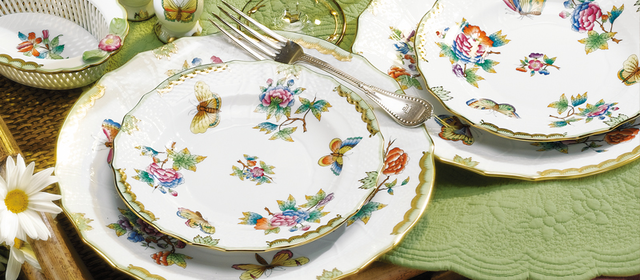Several different terms are used for dinnerware, often interchangeably, which can be confusing for consumers. If you’re buying gifts for people who want something quite specific, it’s important to understand key differences. The following brief guide explains the differences between fine china and dinnerware, including care tips. You’ll be glad you have this knowledge the next time you’re looking for distinctive tabletop ware for yourself or your favorite newlyweds!
What is Fine China?
Although it isn’t capitalized, the origins of this word do indeed derive from the country China. Fine china was first produced during the Tang dynasty (618-907). The early 8th century of this dynasty was a golden age in which beautiful art and culture flourished. Fine china is made from kaolin, a type of white clay. Porcelain is also made from kaolin, but the firing temperature is higher than that of fine china, making it more durable.
The word porcelain derives from the Latin word porcella, which means seashell. Both fine china and porcelain are smooth, white, and lustrous in their glazed form. When porcelain is unglazed, it is known as bisque or biscuit, but that form isn’t used in tableware because it’s too porous. When people use the word china in America, it is often used more generically, referring to high-quality dishes used for special occasions, rather than every day, more casual tableware. The latter is typically made from a denser type of clay called stoneware, melamine, bamboo, and even recycled materials.
Bone China vs Fine China
It took many centuries before European companies were able to match the hardness, translucency, exquisite colors, and beauty of fine Chinese porcelain. Although antique Chinese porcelain continued to be greatly valued by collectors, companies such as Meissen, Royal Limoges, Wedgwood and others started manufacturing luxury dinnerware, ornaments, and figures, some of which was made of bone china.
The English company Spode was the first company to manufacture bone china in 1790, using human bone ash. Today, bone china is made from feldspar, ball clay, quartz, and kaolin with cow bone that has been finely ground into a powder or ash. Most bone china contains between 25 and 45 percent of bone ash in the mixture. The addition of bone ash results in tableware that has a warmer white tone and greater translucency than fine china. In many instances, pieces are marked bone china on the underside, along with the company hallmark and sometimes the pattern name.
Taking Care of Fine China
Although nearly all everyday tableware can be microwaved and safely washed in a dishwasher, that is not the case for fine china, porcelain, and bone china. Care should be taken when handling quality dishes whether they are antique family heirlooms or modern pieces you enjoy using a few times a year. Anything that is painted or decorated with gold trim should be carefully washed by hand with mild soap. Even if a piece is marked dishwasher safe, cup rims and handles can get chipped during the wash cycle, so it’s better to be safe than sorry.
Sources: https://www.thespruce.com/difference-between-china-porcelain-and-dinnerware-4156820
https://knowledgenuts.com/2013/12/27/difference-between-fine-china-bone-china-and-porcelain/
https://www.thekitchn.com/whats-the-difference-between-china-and-dinnerware-245134
https://www.thespruce.com/verify-bone-china-1908319
https://www.drloriv.com/Tips/ID/4346/Identify-bone-china-vs-porcelain
https://classroom.synonym.com/history-fine-china-6537426.html

